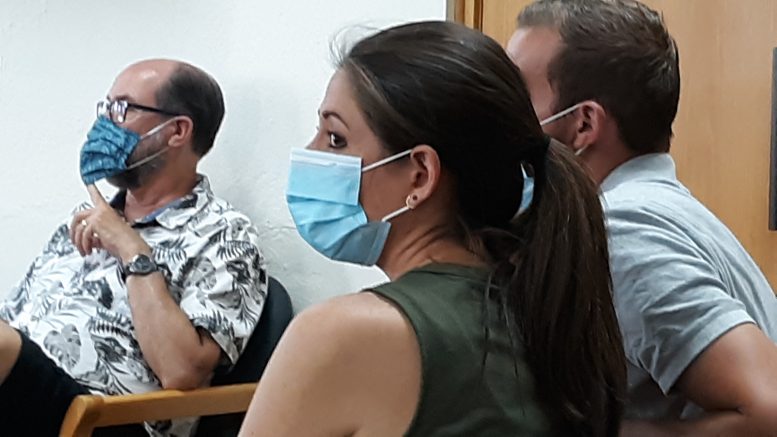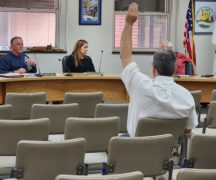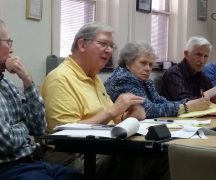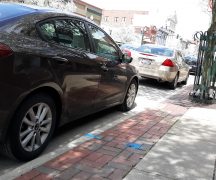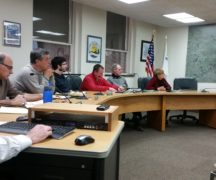By JAN LARSON McLAUGHLIN
BG Independent News
With a unanimous vote of City Council, and the signature of the mayor, Bowling Green now has a mask mandate.
Bowling Green Police Chief Tony Hetrick said officers will be given discretion to issue warnings or citations with a fine of $50 for each offense. Officers will carry masks to give to people with no face coverings.
“Compliance is our main objective,” Hetrick said.
City Council, led by President Mark Hollenbaugh, had a quick turnaround time of less than two weeks on the mask ordinance before voting Tuesday evening to make it law.
Despite the rush, council members heard from hundreds of city residents offering support and opposition to the mask mandate. On Tuesday evening, more comments were offered in letters and in person.
One person talked about the need to support medical workers with more than “hero” signs. One talked about changing his mind about masks as the pandemic wears on. And one talked about the mask mandate being a violation of her Constitutional rights.
When the meeting was over, the seven council members united in their support of the mask ordinance – despite warnings from one citizen that if they enacted the ordinance, they would be replaced in the next election by “God-fearing” candidates.
The mandate was passed as an emergency, and went into effect Tuesday evening.
Hollenbaugh talked about the process of writing the ordinance, with each council member gathering information by contacting the Dayton mayor’s office which recently enacted a similar ordinance, plus talking with law enforcement, the local health department, hospital and churches.
Council member Bill Herald praised the efforts to make city government work efficiently.
“We’ve had to balance individual liberties,” he said, “with community safety.”
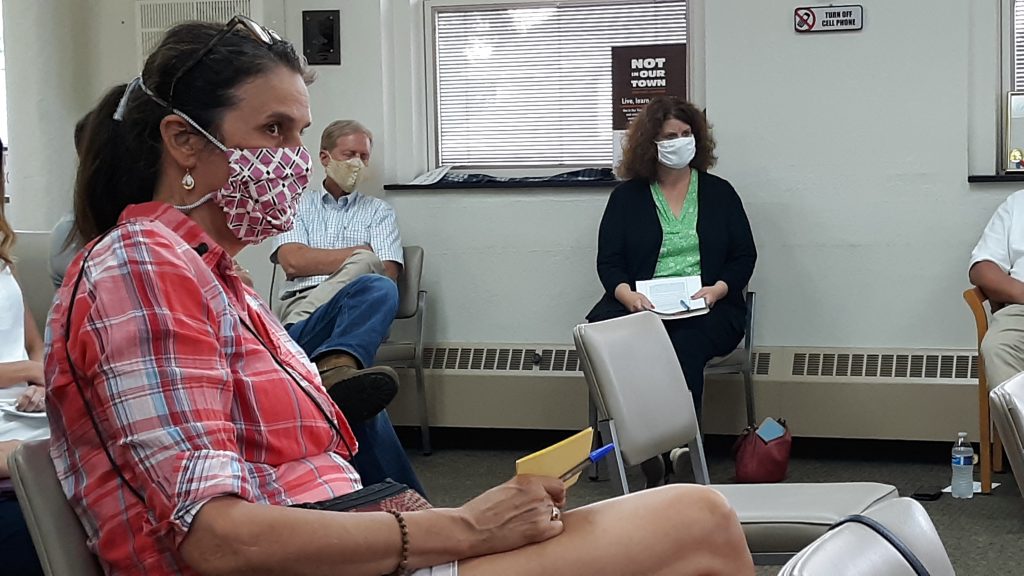
Some of the citizens speaking at Tuesday’s meeting voiced support for community safety. Dr. Wendy Manning referred to the 22% increase in COVID cases in the past week while council worked on the ordinance.
“Delaying is not a good idea,” Manning said.
Vassiliki Leontis urged the community to do more than “hail as heroes” the health care workers.
“We should become heroes, too,” she said, encouraging that the mask mandate be passed to allow for consistent effectiveness.
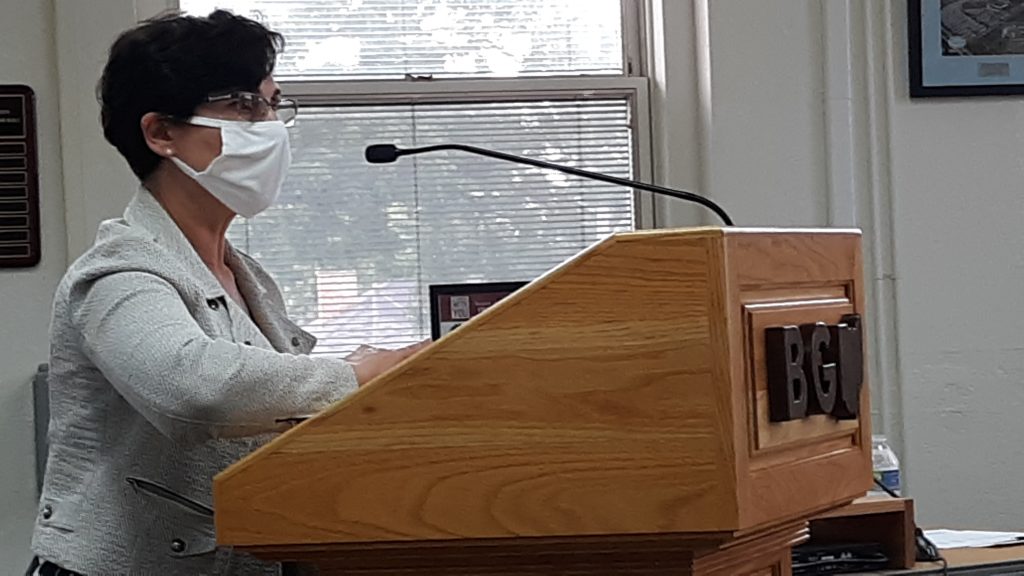
But Jessica Carpenter defended her individual liberties. Though the scientific facts about COVID-19 can be debated – her individual liberties are outlined in the Constitution, she said.
Carpenter said she would not be told what to wear by the seven City Council members. She asked if council was prepared for lawsuits over the mask mandate infringing on people’s rights, and for people to take their shopping money elsewhere.
“People would rather shop in freedom,” Carpenter said.
She then informed council members that if they passed the mask ordinance, they would be ousted by “God-fearing” candidates in the next election.
“I will not comply,” she said. “My family will not take part in your social experiment.”
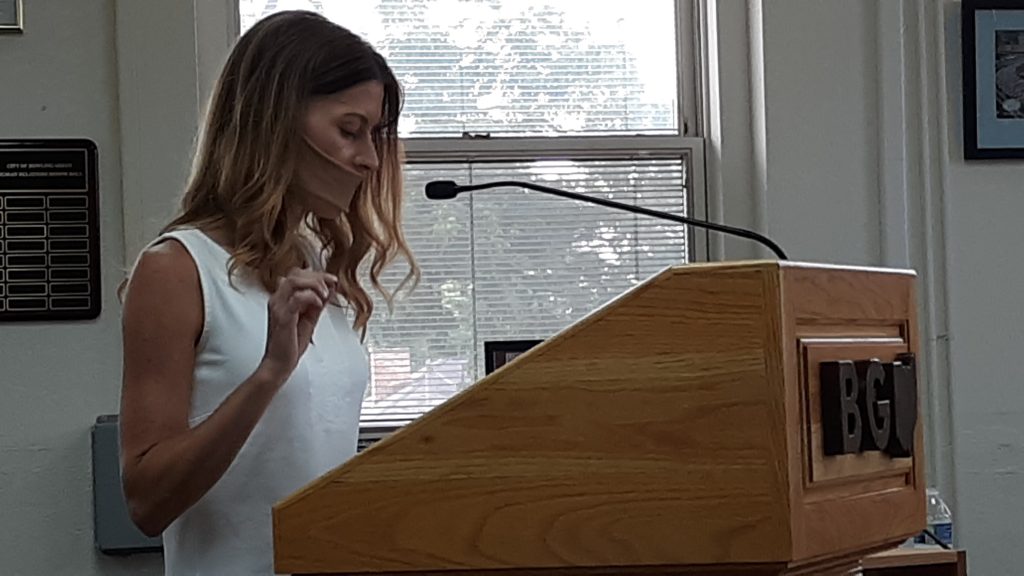
Carpenter cited the “over 99% survival rate” of COVID-19, and the fact that most of the local deaths have been in nursing homes. Though the number of cases continue to grow in Wood County, she said there have been no new deaths attributed to COVID in 52 days.
“Is 52 days without a death not good enough?” she asked City Council.
However, the last of Wood County’s 51 deaths from COVID was documented on June 16, less than a month ago, by the county health department.
Carpenter noted that City Council does not know the exact number of COVID cases in Bowling Green.
“How can you with a clear conscious pass legislation” without that information, she asked.
Carpenter also questioned the need for testing to involve swabs being stuck up into noses. “Shouldn’t a little spit in a cup be enough?”
She also said masks actually put people at risk, since they don’t allow carbon dioxide to be exhaled or oxygen to be inhaled properly.
But council member Neocles Leontis, who is a biochemist, explained to Carpenter that masks don’t impede breathing. “You won’t suffocate with a cloth mask,” he said. But masks do slow the projection of droplets that spread the virus.
“We are not proceeding blindly,” Leontis said of the mask ordinance.
Some letter writers also weighed in Tuesday evening.
Darryl Kosciak, who recently moved to Bowling Green from North Carolina, said he initially opposed mask requirements because of the inconsistent guidance offered by leaders.
“That was then,” he wrote. Wearing a mask to reduce the spread of COVID “is the loving thing to do. My Christian belief calls me to love my neighbor.”
Kale and Jessica Hover wrote in support of the mandate, as did Ann Marie Lancaster, who cited the “devastating impact” on the world from the coronavirus.
“No one likes wearing a mask,” Lancaster wrote. But donning a mask is not a personal choice – just like stopping for a red light or not driving drunk are not personal choices, she wrote.
Ryan Patton expressed his concern about people learning the proper way to handle and wear masks. And Rhonda Garvey talked about the low number of active cases in the Bowling Green area, and all the people dying from COVID-19 in Wood County being 65 years and older.
Prior to voting, council members talked about their reasoning for the ordinance.
Council member Neocles Leontis said the rapidly increasing cases in the Bowling Green area required council to act quickly.
“This is an emergency,” he said.
Council member Sandy Rowland said wearing masks inside buildings used by the public and outside where social distancing cannot be maintained is recommended by the CDC, Wood County Health Department and Wood County Hospital.
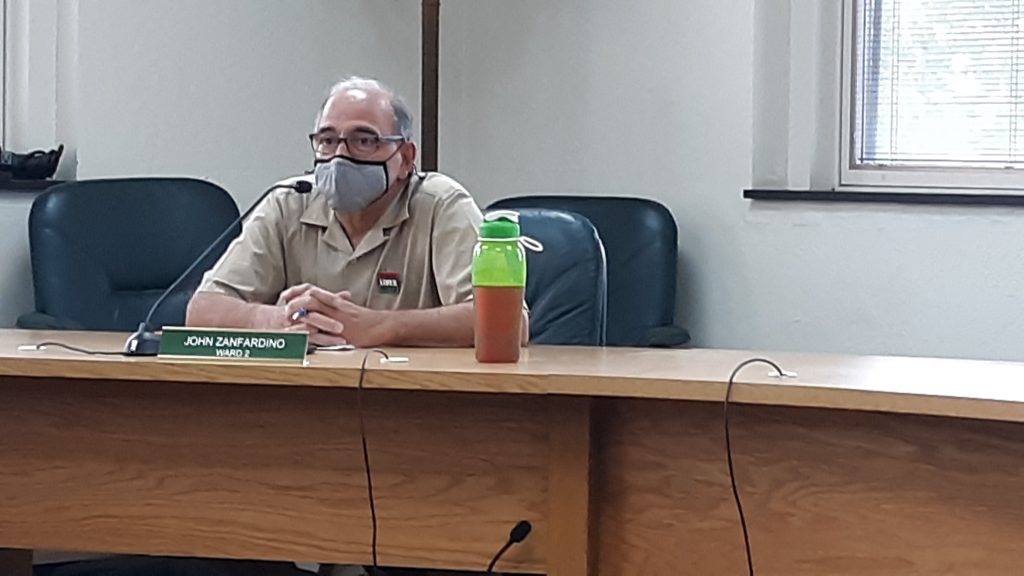
Council member John Zanfardino praised Hollenbaugh for quickly shepherding the ordinance to completion. Despite the rush, he said people had time to voice their opinions to council members. Of the close to 100 comments he received, Zanfardino said 91% were in support of the mask mandate.
“I feel like we have heard what the people have to say,” he said.
Council member Greg Robinette also said he heard from many citizens – many who were very angry on both sides of the issue.
“Civility left the building,” he said.
Robinette said he was not persuaded by the science on either side.
“I feel it’s the right thing to do now,” he said.
“I want Bowling Green not just to survive this pandemic, but to thrive on the other end,” Robinette said. He wants businesses to be able to say open, and kids and teachers to be able to return to school. He wants gatherings of more than 10 people to be permitted. He wants people to mask up for those who are already required to wear face coverings every day for their jobs.
In the name of kindness, humility and community, Robinette said, “I will mask.”
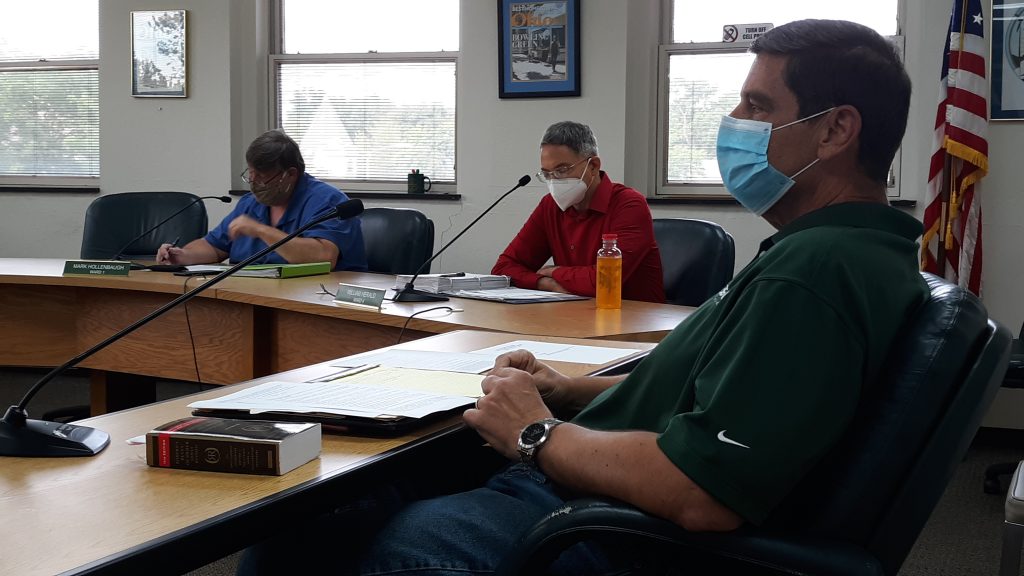
Council member Rachel Phipps agreed the mask mandate will protect the most vulnerable, and allow businesses to remain open. She also reminded those present that this is a temporary tool to get Bowling Green through the pandemic.
“We will not be wearing masks forever,” Phipps said.
In hopes that masks will not be needed as long as originally projected, council agreed that the end date for the ordinance be moved from Dec. 31, 2020 to Oct. 31, 2020. However, that will be subject to change if council agrees in October that the mask mandate be extended.
“We really need to communicate the message that this is temporary,” Herald said.
“This is going to be in effect as long as it’s needed, and not longer,” Hollenbaugh stressed.
The city’s ordinance comes less than a week after Wood County’s status was changed to Level 3-Red, which according to the state means that masks are required in indoor settings used by the public, or outside where proper distance can’t be maintained.
The county status is subject to change each week, when the state updates COVID-19 statistics. But the city ordinance will stay in effect for more than three months and then be re-evaluated.
The mask mandate places the responsibility for face coverings on the individuals – not businesses. If people without masks are confronted by law enforcement, they will be required to explain the exemptions that allow them to not wear a face covering in public places, Hollenbaugh said.
Following are the requirements of the mask ordinance:
When masks are mandated
The ordinance states all individuals within the City of Bowling Green shall wear a face covering over the individual’s nose, mouth, and chin in accordance with the following:
– When entering, exiting, or waiting in line to enter a place of business that is open to the public, and while inside a place of business as to the areas within the place of business that are accessible to, and are intended for the use of, the public. “Place of business” means any facility, building or structure operated by or for a business engaged in the sale or other transaction of any kind for anything of value in exchange for goods, commodities, services, or temporary lodging and that is open to the general public or by appointment, and includes, but is not limited to grocery stores, retail stores, pharmacies, health care facilities, restaurants and bars (including outdoor seating for such facilities), hotels and motels (excluding the rented room or suite), gyms and similar facilities; but excluding religious facilities.
– When entering, exiting, or waiting in line to enter a government operated building or facility that is open to the public, and while inside a government operated building or facility as to the areas within such government facility that are accessible to, and are intended for the use of the public.
– In any public transportation vehicle such as a bus, taxi, or ride-sharing vehicle or any other vehicle for hire or at a transit stop or waiting area for any public transportation.
– In any outdoor space or outdoor place where or when a person is unable to maintain or does not maintain physical separation of not less than six feet from others who are not members of their own household.
When masks are not mandated
The requirement to wear a face covering through this ordinance does not apply in the following situations:
– Any individual who cannot wear a face covering because of a medical condition, mental health condition, special needs, or developmental disability, or who is unable to remove the face covering without assistance, and any individual who should not wear face coverings under the CDC guidance.
– Individuals under 6 years old.
– Restaurant and bar patrons while seated eating or drinking. If a patron is not seated at his or her table or at the bar, a face covering is required.
– School individuals (including students, administrators, and teachers) on or in school or school district facilities, so that schools and school districts may follow the regulations and guidelines promulgated by their governing bodies and the Ohio Department of Education. For this ordinance, “school or school districts” means any public, private, or charter school or institution that provides education for any or all of the following grades or education: kindergarten through twelfth grade; or a university, college, or similar post-secondary institution.
– In settings where it is not practicable or feasible to wear a face covering such as when receiving dental services, medical treatments, or while swimming.
– Walking or exercising outdoors so long as physical separation of not less than six feet is maintained, or while walking or exercising outdoors with other members of the same household.
– While actually engaged in exercising in a gym or other similar indoor facility so long as physical separation of not less than six feet is maintained and the individual wears a face covering at all times when not actually engaged in exercising.
– When an individual is in his or her work office, conference room, or other workspace not intended for use by the general public so long as physical separation of not less than six feet is maintained.
– When inside a personal or commercial vehicle either parked or moving that is not a public transportation vehicle.
– Individuals while acting in their official capacity as a public safety employee or emergency responder when wearing a face covering would interfere with or limit their ability to carry out their official duties or functions. These include peace officers, firefighters, and other public safety or emergency personnel that support public safety operations.
– Individuals complying with the directions of public safety employees or emergency responders.
- Individuals communicating or seeking to communicate with someone who is hearing-impaired or has another disability, where the ability to see the mouth is essential for communication.
What qualifies as a mask
According to the ordinance, “face covering” means a piece of cloth, fabric, or other material that fully covers the mouth, nose, chin, and is secured in place. A face covering may be factory-made or may be handmade and improvised from household materials. Face coverings include, but are not limited to, bandanas, scarves, medical masks, and cloth masks; and also include respirators, N95 masks or other personal protective equipment that provides a higher level of protection than a face covering defined in this Section. A face covering shall be worn so as to cover the mouth and nose and chin in compliance with the CDC’s guidance on wearing face coverings.
The ordinance shall remain in effect until Oct. 31, 2020, unless extended by majority vote of City Council.
Whoever violates this ordinance is subject to a civil penalty in the amount of $50 fine per offense.
The ordinance shall take effect as an emergency measure. The reason for the emergency is the prompt effectiveness of this measure is necessary so as to diminish the spread of COVID-19 in the Bowling Green community, and to protect especially vulnerable citizens from the effects of COVID-19, and thereby protect the public health, safety, and well-being of citizens.
(See other communities in Ohio that have passed face covering ordinances.)

